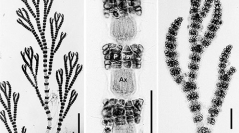

 Cryptogamie, Algologie
23 (4) - Pages 277-289
Cryptogamie, Algologie
23 (4) - Pages 277-289We studied the vegetative, reproductive, and developmental morphology of Ceramium recticorticum Dawson. Thalli are alternately branched and have four peraxial cells with four to five pseudoperiaxial cells. Acropetal and basipetal cortical cells are produced by transverse division of periaxial and pseudoperiaxial cells and are rectangular, horizontally elongated, and regularly arranged in four to five columns and rows. Spermatangia are produced on the adaxial side of the upper branches and later in whorls. Cystocarps are spherical and surrounded by 2-4 involucral branches. Tetrasporangia are produced in an opposite sequence, completely covered by cortical cells, and arranged in whorls. The development of spermatangia and cystocarps are described for the first time and conform to the description of the genus. Ceramium recticorticum is similar to C. fimbriatum Setchell et Gardner, C. flaccidum (Kützing) Ardissone, and C. gracillimum (Kützing) Griffiths et Harvey ex Harvey var. byssoideum (Harvey) Mazoyer in sharing a horizontally elongated basipetal cortical cell by transverse division of periaxial cells and rhizoids composed of unicellular filaments with pads produced from periaxial cells. These taxa may be considered as a group of closely related species.